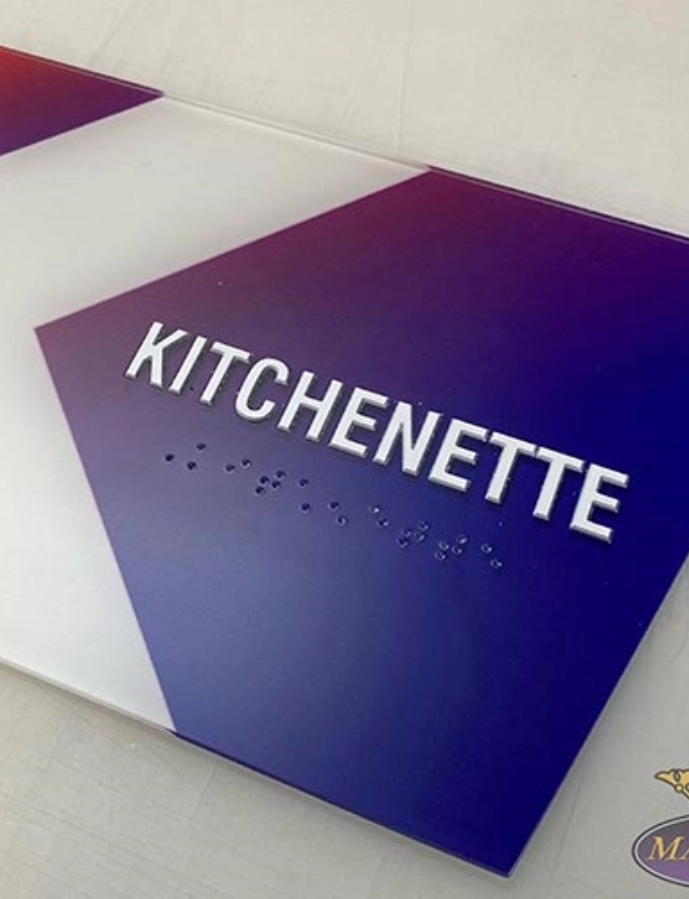
In today’s world, inclusivity and accessibility are crucial components of running a successful and responsible business. One of the key aspects of creating an accessible environment is ensuring that your signage meets ADA (Americans with Disabilities Act) standards. Custom ADA signs not only help businesses remain compliant with regulations but also enhance the overall experience for all visitors. This guide will take you through everything you need to know about custom ADA signs for your business.
What Are ADA Signs?
ADA signs are signs that comply with the Americans with Disabilities Act, a law enacted to ensure that individuals with disabilities have equal access to public spaces and services. These signs include features like tactile text, Braille, and high-contrast visuals to assist those with visual and other disabilities. Common examples include restroom signs, exit signs, room numbers, and wayfinding signs.
Why Are Custom ADA Signs Important?
- Regulatory Compliance: Adhering to ADA standards helps businesses avoid potential legal issues and fines. The ADA outlines specific guidelines that public spaces must follow to be considered accessible.
- Inclusivity: Custom ADA signs are an essential part of creating an inclusive environment where everyone, regardless of ability, feels welcome.
- Enhanced Branding: Custom signs allow businesses to maintain brand consistency by integrating logos, brand colors, and unique designs while still meeting ADA requirements.
- Improved Navigation: ADA-compliant signs make it easier for all visitors to navigate through a building, improving the overall customer experience.
Key Features of Custom ADA Signs
To ensure ADA compliance, custom signs must have certain features:
- Tactile Text and Braille: Raised characters and Braille translations help visually impaired individuals read the signs by touch.
- High-Contrast Colors: The color contrast between text and background should be sufficient to make the sign easy to read.
- Non-Glare Finish: Signs should have a matte or non-glare finish to improve readability under various lighting conditions.
- Specific Placement: ADA standards specify the height and location at which signs should be placed to be accessible to all.
Types of Custom ADA Signs
- Room Identification Signs: Indicate permanent spaces such as offices, conference rooms, and restrooms. These must include tactile lettering and Braille.
- Directional and Wayfinding Signs: Help guide visitors to various locations within the building.
- Informational Signs: Provide essential information, such as building policies or instructions, that may need to be accessible to everyone.
- Restroom Signs: Include gender symbols, Braille, and text to indicate facilities.
Steps to Create Custom ADA Signs for Your Business
- Understand ADA Guidelines: Familiarize yourself with the latest ADA regulations regarding signage to ensure compliance.
- Select a Reputable Manufacturer: Partner with a company that specializes in custom ADA signs and has experience in crafting compliant products.
- Design with Purpose: Choose colors, fonts, and layouts that align with your brand while ensuring high contrast and readability.
- Incorporate Braille and Tactile Text: Ensure the inclusion of raised characters and Grade 2 Braille for full compliance.
- Consider Placement: Strategize the location of each sign to optimize visibility and accessibility as outlined in ADA guidelines.
Benefits of Custom ADA Signs for Your Business
- Enhanced Accessibility: Custom signs tailored to your space make it easier for people with disabilities to navigate your building.
- Stronger Brand Identity: Customized signs help reinforce your business’s branding and create a cohesive look throughout your establishment.
- Legal Protection: Adhering to ADA requirements protects your business from fines and potential lawsuits.
- Positive Reputation: An inclusive, accessible space fosters a positive public image and encourages repeat visitors.
Common Mistakes to Avoid
- Using Low-Contrast Colors: Ensure there is a significant contrast between text and background colors.
- Neglecting Proper Placement: ADA guidelines dictate specific placement rules that must be followed for compliance.
- Ignoring Tactile Requirements: Failing to include Braille or raised text can render your signs non-compliant.
Conclusion
Investing in custom ADA signs is not just about meeting legal standards—it’s about creating a welcoming and accessible environment for everyone. By understanding the importance of ADA signage and implementing it effectively, your business can stand out as inclusive, responsible, and visitor-friendly.
When choosing ADA signs, ensure they reflect your brand while adhering to all necessary compliance rules. Doing so will benefit your business through enhanced accessibility, legal protection, and a strong reputation as a considerate, inclusive space.